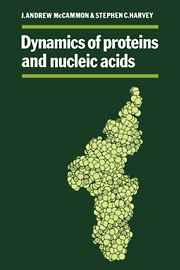Book contents
- Frontmatter
- Contents
- Preface
- 1 Introduction
- 2 Structure of proteins, nucleic acids, and their solvent surroundings
- 3 Dynamics of proteins, nucleic acids, and their solvent surroundings
- 4 Theoretical methods
- 5 Short time dynamics
- 6 Local structural transitions
- 7 Global structural changes
- 8 Dynamics of molecular associations
- 9 Recent developments and future directions
- Appendix 1 Numerical integration of the equations of motion
- Appendix 2 Detailed description of computer programs and procedures for energy minimization and molecular dynamics
- Appendix 3 Molecular dynamics at constant temperature and pressure
- References
- Index
Appendix 2 - Detailed description of computer programs and procedures for energy minimization and molecular dynamics
Published online by Cambridge University Press: 05 June 2012
- Frontmatter
- Contents
- Preface
- 1 Introduction
- 2 Structure of proteins, nucleic acids, and their solvent surroundings
- 3 Dynamics of proteins, nucleic acids, and their solvent surroundings
- 4 Theoretical methods
- 5 Short time dynamics
- 6 Local structural transitions
- 7 Global structural changes
- 8 Dynamics of molecular associations
- 9 Recent developments and future directions
- Appendix 1 Numerical integration of the equations of motion
- Appendix 2 Detailed description of computer programs and procedures for energy minimization and molecular dynamics
- Appendix 3 Molecular dynamics at constant temperature and pressure
- References
- Index
Summary
This appendix is intended to serve as a resource to which one can turn when beginning to design, use or modify a package of computer programs for molecular modeling studies using energy minimization, normal mode analysis, and/or molecular dynamics. Among the more common packages (and the principal references on each) are AMBER, developed at the University of California at San Francisco (Weiner & Kollman, 1981); CEDAR, developed at the University of North Carolina (Carson & Hermans, 1985); CHARMM, developed at Harvard University (Brooks et al., 1983); and GROMOS, developed at the University of Groningen (van Gunsteren et al., 1983, and references therein).
Topics to be discussed here include the data files required for simulations and the sequence of operations necessary to properly initiate a molecular dynamics simulation. As an example, we describe one particular package of programs, those developed for our studies on the structure and dynamics of phenylalanine transfer RNA (Harvey & McCammon, 1981; Tung et al., 1984; Harvey et al., 1984, 1985; Prabhakaran et al., 1983, 1985a). We hope that a discussion of this example will clarify many of the details of the computer algorithms and answer most of the questions commonly posed by newcomers to the field. We do not discuss the various numerical methods that are used, since they are described elsewhere (see section 4.4 on energy minimization and appendix 1 on molecular dynamics).
- Type
- Chapter
- Information
- Dynamics of Proteins and Nucleic Acids , pp. 181 - 187Publisher: Cambridge University PressPrint publication year: 1987
- 1
- Cited by

